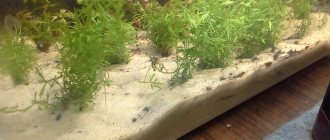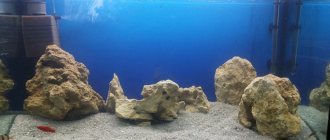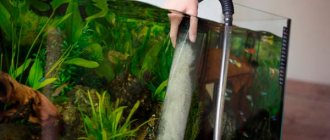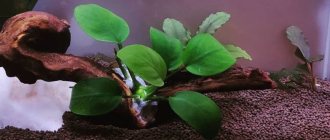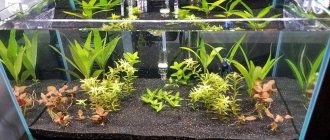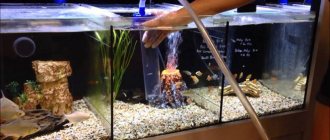High-quality sand for an aquarium is the most important biochemical component of an artificial ecosystem. It acts as a substrate for green spaces, a natural filter, and a habitat for numerous colonies of microorganisms. The correct choice of soil is a serious issue, the solution of which affects the fate of the entire underwater kingdom.
Sand in an aquarium - pros and cons
In modern aquarium keeping, several types of natural or artificial soil are used - coral chips, deposit, ready-made nutrient mixtures, baked clay soil, sand and gravel. The main criterion when choosing the optimal composition for a home container is what specific fish and plants will inhabit the underwater world. The most widespread is accessible and simple sandy soil, in which most unpretentious exotic creatures live well.
Many lovers prefer a bright artificial mixture to the natural environment, turning the bottom of the container into a multi-colored fantastic landscape. The question of whether sand is needed in an aquarium worries beginners who decide to have a small tank with indoor fish at home. To better navigate this topic, it is advisable to know the main disadvantages and advantages of this type of soil.
What is good about sand for an aquarium:
- Aquatic vegetation grows and takes root better on sand.
- It is easier to clean the sandy bottom; this process can be easily carried out using a siphon, passing the device close to the surface.
- Sand soil perfectly performs its biological functions.
- This type of soil is ideal for bottom-dwelling creatures that love to dig in light layers.
- Sand always attracts the natural look of an aquarium interior.
Disadvantages of sandy soil:
- Washing and preparing sand for an aquarium involves several long and labor-intensive steps.
- This type of soil requires constant periodic maintenance, otherwise it will quickly become covered with layers of debris.
- Certain types of sand can change the chemical composition of the aquatic environment.
- Pure sandy soil has few nutrients for vegetation, so fertilizing with fertilizers is required.
Types of soil for an aquarium
All existing substrates used in aquarium farming can be divided into 3 groups:
- natural (quartz, pebbles, gravel, sand, lava);
- processed (fired clay, expanded clay);
- artificial (plastics, glass).
In addition, there are neutral and nutritious types of soil. Neutral litter does not contain substances beneficial to plants; a sufficient amount of organic matter accumulates in them only a few months after launch. Nutrient mixtures are used in herbal aquariums and, depending on the composition of the fertilizer, serve as a source of micro- or macroelements.
Types of soil for an aquarium.
Cleaned sand
One of the widely used natural neutral types of bottom cover is sand. Preference should be given to river sand, because... marine is usually smaller, cakes and does not allow water to pass through. For better bedding aeration, it is recommended to choose sand with a particle size of at least 1.5-3 mm. To increase soil aeration, sand of different fractions should be poured in layers: coarser sand on top of finer ones.
Which sand is best for an aquarium?
For the normal functioning of the ecosystem, the chemical composition of the soil, its origin, the thickness of the layers, and the fraction of soil particles play a role. If you pay attention exclusively to the decorative component, then the aquarist will not achieve a good result right away. It is advisable to analyze the situation and the goals set, correctly selecting the appropriate composition that will cover the bottom of the glass container.
Main characteristics of sandy soil for an aquarium:
- Sand fraction. Microscopic grains and large pebbles are not suitable. Sand with a particle fraction of 1.5-2 mm is considered optimal for an aquarium. If the grains are smaller, then aeration in the soil is poor, stagnation is observed, and pathogens multiply. Organic matter is washed out of large pebbles, and plants on them take a long time to take root.
- Thickness of sand for an aquarium. A layer of 4-6 mm suits most underwater plantings; soil of a different thickness is required for rare plant species.
- Types of sand for an aquarium. The color of the soil indicates the chemical composition of its particles. It is not advisable to take grains of sand that are red or yellow in color for work; they contain a high percentage of iron. It is advisable to remember that the use of limestone chips leads to an imbalance in the rigidity of the water balance, which ends disastrously for many creatures.
Optimal types of sand for an aquarium:
- river sand;
- quartz sand;
- sea sand;
- black sand;
- aragonite sand for home aquarium.
River sand for aquarium
If you are looking for a cheap and simple substrate for an aquarium, then sand from the river bottom is perfect for this purpose. It is optimal to use material collected on shallows, where there is the least amount of clay. Otherwise, the amateur will have to work for a long time, washing the composition to remove impurities. River sand for an aquarium of a large fraction allows water to pass through normally, and is good for feeding all underwater plants.
Sea sand in an aquarium
For freshwater artificial reservoirs, coarse soil collected on the seabed is suitable, but before use it must be thoroughly washed, removing residual salt and other impurities. Ordinary sand from the sea serves well in an aquarium; plants grow well on it and fish reproduce well. For better calibration, you can sift it through a sieve, separating shell fragments along the way. It is advisable to check the water for alkalinity after filling using ready-made tests.
In marine aquariums, you can place “live sand” with colonies of marine microorganisms that are not destroyed during transportation. It does not go through the drying process and helps to establish water balance faster. It is prohibited to store this type of soil in the air; after a few hours the microflora dies, and “live sand” becomes unsuitable for an aquarium. Often, ready-made marine substrates with bacteria are laid in a thin layer on simple quartz or river soil.
Coral sand for aquarium
Aragonite soil comes from sediments on the seabed where the crushed remains of corals and shellfish accumulate. This soil has a high calcium content, so decorative sand for an aquarium made from the skeletons of living organisms increases the hardness of the environment. Coral chips are sold in a variety of fractions; they are optimally used in the marine and pseudomarine underwater world, and alkaline ecosystems.
White sand in an aquarium
Hobbyists often use both white soil and colored mixtures to decorate containers. The soil for a white sand aquarium can be of different origins, which greatly affects the chemical properties. This color is often found in nature, so you need to use the purchased soil carefully, after carefully familiarizing yourself with its composition.
Types of white sand for an aquarium:
- river sand;
- sand from the seabed;
- aragonite sand made of small white corals and shells;
- quartz sand obtained by artificially crushing milky white quartz.
Black quartz sand for aquarium
This color is given to the soil by ilmenite, magnetite or hematite, which is present in varying proportions in its composition. Black sand can be used in an aquarium without restrictions; it does not change the characteristics of the environment, so the aquarist does not have to worry about an arbitrary increase in water hardness. Compared to snow-white soil, it is more profitable to use a dark background for the underwater world; all types of living organisms look brighter on it. To reduce the contrast, it is advisable to use not pure black sand, but a substrate with a slightly grayish tint.
Colored sand for aquarium
Multi-colored mixtures help to arrange the interior of the underwater kingdom in an unusual way, easily creating varied and bright fantastic landscapes at the bottom to match your exotic pets. When asking what kind of sand is needed for an aquarium, it is advisable to follow safety measures. Colored soil should be harmless for fish and not affect the percentage of hardness and acidity of the environment. A high-quality quartz substrate is suitable, which it is advisable to rinse before backfilling.
Advantage of using sand
- Using sand as a substrate for an aquarium helps create a comfortable environment for its inhabitants, bringing it as close as possible to the conditions of the natural habitat.
- Sandy soil prevents organic waste from penetrating into the substrate, which makes cleaning the bottom of the aquarium easier.
- Sand promotes the rooting and well-being of algae.
- Quartz sand for an aquarium is involved in the digestion of some types of fish.
- Many aquarium fish like to dig in loose sand.
- Sandy soil provides greater softness of water than when using gravel or pebbles.
How to prepare sand for an aquarium?
It is advisable not to trust advertising brochures and prepare the soil the day before pouring it into a container with fish. Coarse sand for an aquarium with a normal composition must be subjected to several basic operations that will make it safe for aquatic inhabitants. The process of preparing the substrate is simple and suitable for any beginner.
Stages of preparing sand for an aquarium:
- We wash with running water in a convenient container. Frequent work with sand in enamel basins or buckets leads to damage to the coating.
- For convenience, we divide the sand into portions of 3-4 kg.
- We rinse the soil until the flowing liquid becomes completely transparent.
- The remaining sand dust rises to the top and is removed.
- Disinfection is carried out by boiling for 15-20 minutes with constant stirring of the sand mixture.
- After boiling, the soil is washed again.
- Other methods of disinfection are calcination in ovens, treatment with a 10% chlorine solution.
- Soaking light sand in a strong manganese solution helps make light sand darker.
- Excess carbonates are removed from aquarium sand with a 30% citric acid solution. The treatment ends after the release of air bubbles into the water stops, then the soil is washed.
Useful tips
The mound has been processed, now you need to properly place it in the aquarium. And before that, prepare it properly, since untreated can contaminate the flora and fauna of your aquarium due to harmful substances and microorganisms that may be in it. It is especially carefully processed when mined by hand.
First of all, rinse this substance. You can put the prepared soil in any sufficiently deep container, for example, a bucket or basin and rinse it under running water until the water that drains from it becomes clear. To achieve the best washing effect, it is advisable to wash the soil in parts. You need to know how to prepare disinfection: pour the required amount of soil with a manganese solution (add manganese powder to the water until the liquid becomes cherry-colored). Leave the resulting solution for a couple of days and then rinse with clean running water.
If you are very concerned about the safety of marine life, you can thoroughly boil sand filled with water and then drain the water. It is not recommended to clean it with any detergents as such detergents contain toxic chemicals. The most optimal way is to boil or calcine the sand directly in the oven. If you choose the option in the oven, then you should distribute it evenly on a baking sheet and heat it in this way for 30 minutes at a temperature of 100 degrees.
How to pour sand into an aquarium?
It is more convenient to work with a plastic spatula; it helps to spread the mixture evenly without breaking the delicate glass. A substrate or peat with nutrients is often poured onto the bottom to speed up the start-up of the water system. It is better to place heavy stones on a foam mat to prevent splitting. We pour plain or decorative sand for an aquarium into a container without water, hold the spatula at the bottom, any pebble from a height can break the surface.
We make a slope towards the front wall, the composition with a coarse fraction is poured from below, and fine sand is laid on top. A common option is a layer of sand at the back up to 8 cm, at the front wall - up to 2 cm. If desired, use a shovel to give the soil a unique shape or make the layer of soil for the aquarium even. Multi-level compositions are easier to create using stones, dividing the bottom into zones.
How much sand do you need in an aquarium?
It is easy to calculate the amount of soil for a sand aquarium using the average formula. First, we determine the volume of the tank in liters, and then divide the resulting number by 10. It is convenient to first weigh a liter of prepared dry sand in order to obtain the required weight of soil in kilograms when you have to purchase it in a store. These calculations are approximate, but they help determine the amount of soil in the aquarium needed for fish and plants growing in sand.
How to make a composition with your own hands
You can prepare a nutrient mixture for aquarium plants yourself.
For this you will need:
- Charcoal (activated granules or natural birch). It absorbs harmful substances from the soil, cleaning the litter.
- Clay is a source of minerals necessary for plant life.
- Sorbent (vermiculite) is an active additive that retains nutrients in the soil and does not allow them to dissolve in water.
- Peat (pressed or in granules) is a source of organic substances required for plant nutrition. In its natural form, it can cause soil acidification.
- Finely chopped fallen leaves and coconut fiber are also sources of beneficial organic matter. The foliage of some tree species decomposes too quickly or too slowly, so coconut fiber is preferable. The release of nutritional compounds from coconut fiber occurs evenly and continuously.
- Coarse sand or small pebbles.
Do-it-yourself nutritious soil for plants in an aquarium.
Caring for sand in an aquarium
Fish waste, plant debris and food pollute the soil, releasing toxins into the water. For the first time, cleaning with a siphon is carried out 30 days after the launch of the ecosystem, the remaining work is carried out at intervals of a month. Turbid water from sand in the aquarium will not disturb the fish; they will not have to be resettled. All sediment can be removed with complete cleaning, but for this purpose you will have to remove fish and plants, and rinse the sand in running water. Thorough cleaning of the tank and soil is carried out once a year.
How to rinse sand for an aquarium?
The problem of how to clean sand in an aquarium can be solved with a simple siphon. A tube with a funnel gently loosens the soil, sand and gravel settle down, and dirt is sucked into the tube. After a few seconds, the siphon moves further and the cycle of work repeats. Be sure to add liquid to the container to restore the required volume. The cloudiness of the water at first may bother the amateur, but this is a normal process and soon the ecosystem is restored.
